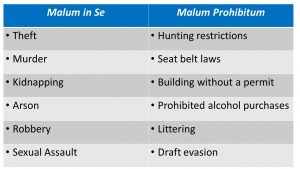1.2: Not All Crimes are Immoral; Not All Moral Wrongs are Crimes
- Page ID
- 97130
Morality and criminal law frequently overlap. It is common to view a violation of criminal law as an immoral act. However, there is no universal moral code. While philosophers will continue to debate the definition of ‘morality’, we will focus on a more modest task. The criminal law does not punish every moral wrong. Instead, the relationship between crime and morality looks more like a Venn diagram.
Figure 1.1 – Venn Diagram showing the overlap between moral wrongs and criminal wrongs.

On one hand, we have moral wrongs (represented as “A”) that are not necessarily criminal acts. For example, adultery is frequently considered immoral, but few believe such an act should give rise to criminal liability. Likewise, failing to help a small child drowning in a swimming pool may seem morally questionable, but the criminal law generally does not require a person to put themselves in harm’s way, even if most of us believe that we should intervene if we can. On the other hand, we have criminal laws that may not, at first blush, implicate our collective morality (represented as “B”). For example, laws that criminally punish wasting big game meat in the field (AS 16.30.010) or criminal laws that mandate jail for driving without a proper license (AS 28.15.291) are generally not considered moral wrongs (beyond the moral failure to follow the law) but they are criminalized nonetheless. Finally, there are activities that society generally considers morally wrong and are also criminal law violations (represented as “C”). These acts include behaviors such as murder, sexual assault, and robbery. A significant portion of criminal laws is also immoral.
Most of us can agree that some acts should always be criminal – e.g., execution murder, forcible rape, or robbery. Universal agreement exists that these acts should be outlawed, and individuals who commit these acts should be punished. People may disagree about the extent or type of punishment, but they generally do not disagree about the underlying conduct. Within the context of criminal law, we refer to these crimes as “malum in se.” A crime is “malum in se” if it is “inherently evil.” See Kinney v. State, 927 P.2d 1289 (Alaska App. 1996) (citing Wayne R. LaFave and Austin W. Scott, Jr., Substantive Criminal Law (1986), sec. 1.6(b), Vol. 1, p. 45.). Mala in se offenses are criminal behaviors that society universally considers to be wrong and morally unacceptable.
But the law criminalizes much more conduct than just murders, rapes, and robberies. Legislators routinely criminalize less dangerous (or non-dangerous) acts. Alaska, like most states, has criminalized drug possession, prostitution, and driving without a valid license. There is much debate as to whether this type of conduct is immoral. Under the law, these criminal acts are considered “malum prohibitum.” A crime is “malum prohibitum” if the act is criminal because it violates the criminal law. A “malum prohibitum” offense is “not inherently evil [but is] wrong only because [it is] prohibited by the legislature.” See id.
We will revisit the distinction between malum in se and malum prohibita in Chapter 4, but for now, the below chart helps summarize the difference.
Figure 1.2 – Chart comparing malum in se offenses and malum prohibita offenses.


